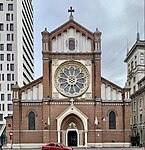Institute of Mathematics of the Romanian Academy
1949 establishments in RomaniaAC with 0 elementsBuildings and structures in BucharestInstitutes of the Romanian AcademyMathematical institutes ... and 1 more
Organizations established in 1949

The "Simion Stoilow" Institute of Mathematics of the Romanian Academy is a research institute in Bucharest, Romania. It is affiliated with the Romanian Academy, and it is named after Simion Stoilow, one of its founders.
Excerpt from the Wikipedia article Institute of Mathematics of the Romanian Academy (License: CC BY-SA 3.0, Authors, Images).Institute of Mathematics of the Romanian Academy
Calea Griviței, Bucharest
Geographical coordinates (GPS) Address Phone number Website Nearby Places Show on map
Geographical coordinates (GPS)
| Latitude | Longitude |
|---|---|
| N 44.444097222222 ° | E 26.088497222222 ° |
Address
Institutul de Matematică „Simion Stoilow”
Calea Griviței 21
010702 Bucharest (Sector 1)
Romania
Open on Google Maps









